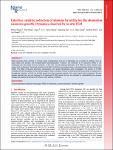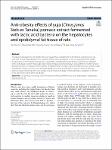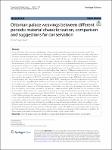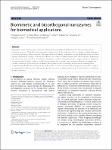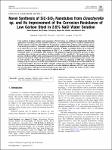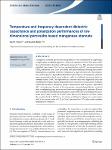Search
Author
- Manyk, T. (3)
- Murawski, K. (3)
- Baumgartner, Jörg (2)
- Guizani, Chamseddine (2)
- next >
Subject
Date issued
- 2023 (187)
Has File(s)
- true (187)
Search Results
Metal nanowires show promise in a broad range of applications and can be fabricated via a number of methods, such as vapor–liquid–solid process and template-based electrodeposition. However, the synthesis of Al nanowires (NWs) is still challenging from the stable alumina substrate. In this work, the Ni-catalyzed fabrication of Al NWs has been realized using various Al2O3 substrates. The growth dynamics of Al NWs on Ni/Al2O3 was studied using in situ transmission electron microscopy (TEM). The effect of alumina structures, compositions, and growth temperature were investigated. The growth of Al NWs correlates with the Na addition to the alumina support. Since no eutectic mixture of nickel aluminide was formed, a mechanism of Ni-catalyzed reduction of Al2O3 for Al NWs growth has been ... |
This study investigated the anti-obesity effects of yuja pomace extract fermented with lactic acid bacteria in rats with high-fat diet-induced obesity over a period of eight weeks. Epididymal fat cell size was significantly smaller, by about 33%, in the treatment groups given yuja pomace extract fermented with lactic acid bacteria compared to the CON group. Electron microscopic observation of hepatocyte microstructure showed that the number of lipid droplets was lower in hepatocytes, the number of mitochondria was higher, along with distinct cristae, and the rough endoplasmic reticula were well developed with stacks of cisternae and ribosomes. Thus, it is believed that yuja pomace extract fermented with lactic acid bacteria, by influencing body weight and lipid accumulation, is effe... |
Historical textiles, which are an invaluable part of the cultural material heritage, and the materials used in their production bear witness to the social past. Although a textile object was originally produced out of necessity, later it became a symbol of magnificence, power, and might. The most important basic elements that contribute to these properties are the materials used in its production, among which silk fiber, and metallic threads containing gold and silver are the leading ones. In addition to the aging behavior of textile objects due to their organic structure, the deterioration process is accelerated due to various factors such as use, environmental factors, mismanagement, inappropriate storage and display conditions, incorrect restoration-conservation practices, natura... |
Hybrid organic–inorganic lead halide perovskite materials have established themselves as a competitive solar cell technology, with high efficiencies and simple processing. However the main drawback of these materials is currently their stability, which is complicated by the potential to release the toxic element lead into the environment. Attempts to replace lead for less-toxic starting materials have generated significant research interest. Any candidate material must have enhanced stability and comparable performance to lead halide perovskites, and an understanding of the structure is key to developing these materials to be competitive. This review provides a brief overview and reference of experimentally determined crystal structures of lead-free perovskite materials. The most pr... |
Nanomaterials, especially ferrites, have various applications in mechanical, electrical, and optical fields. However, their abilities in environmental applications remain unexplored. In this work, the flash auto-combustion method has been used to prepare three different compositions of CuFe2O4, Zn-CuFe2O4, and Co-CuFe2O4 nanocomposite. The structure, spectroscopic, surface, and morphological properties of the prepared samples were characterized using XRD, FTIR, BET, and HRTEM, respectively. According to XRD analysis, the prepared ferrites consist of nanocrystalline particles with sizes of 24.5, 37.5, and 32.6 for CuFe2O4, Zn-CuFe2O4, and Co-CuFe2O4, respectively. Zn-CuFe2O4 and Co-CuFe2O4 had a single cubic phase, while a tetragonal phase was formed in CuFe2O4. The addition of cobal... |
Nanozymes mimic the function of enzymes, which drive essential intracellular chemical reactions that govern biological processes. They efficiently generate or degrade specific biomolecules that can initiate or inhibit biological processes, regulating cellular behaviors. Two approaches for utilizing nanozymes in intracellular chemistry have been reported. Biomimetic catalysis replicates the identical reactions of natural enzymes, and bioorthogonal catalysis enables chemistries inaccessible in cells. Various nanozymes based on nanomaterials and catalytic metals are employed to attain intended specific catalysis in cells either to mimic the enzymatic mechanism and kinetics or expand inaccessible chemistries. Each nanozyme approach has its own intrinsic advantages and limitations, makin... |
Coat synthesis of silicon carbide and composites of Si derivatives is a challenge for high-quality thin film applications, including corrosion resistance industries. A novel fabrication process of silicon carbide-silicon dioxide nanotube composites (SCDNTs) was developed by a solid reaction of silicon-carbon (marine sponge Cinachyrella sp.) resources. Trimetallic catalyst (Fe/Ni/Zr) supported on different Al2O3 media with heating in an argon flow was used to prepare SCDNTs composite. A higher crystallinity degree of the nanocomposites is attained at a heating temperature of 1200 °C as a suitable starting temperature to have a reasonable degree of crystallinity. XRD analysis of the prepared composite showed the presence of polycrystalline silicon dioxide and two phases of silicon car... |
Unmanned Aerial Vehicles (UAVs) are often preferred for modeling cultural heritage buildings due to their costs and time savings. The need for data collection, analysis, processing, and visual presentation in the context of cultural heritage buildings has become prominent, underscoring the significance of the concept of Level of Detail (LoD). The utilization of CityGML LoD standards enhances the performance of visual presentations, decreases the geometric complexity of objects, and enables users to view the model at the desired level of detail within a computerized environment. Within the scope of this study, it is aimed to determine the accuracy analysis of the 3D model for a cultural building, which is named Hekimbaşı Hunting Lodge, at different LoDs. |
Manganese stannate perovskite nanoparticles were synthesized by applying a complexation mediated approach. Rietveld refinement of the XRD data exhibited orthorhombic structure with space group of Pnma. The structure included eightfold coordinated Mn2+ cation, surrounded by eight O2− anions and formed MnO8 polyhedra unit. Each polyhedra unit interconnected through the corner-sharing SnO6 octahedra with the formation of a cage-like network. The temperature and frequency dependent dielectric performances of manganese stannate were measured in the form of a device, which exhibited maximum dielectric constant value ~ 3445. The high dielectric constant value was originated due to the contribution of space charge polarization and orientation polarization of dipoles within the measured freq... |
A flexible carbon fiber-confined yolk-shelled silicon-based composite is reported as an anode material for lithium storage applications. Silicon nanoparticles (Si NPs) are confined by the N-doped hollow carbon cages (Si-NHC) and these uniform dispersed yolk-shell-structured Si-NHC units were encapsulated by the carbon fibers within an interconnected three-dimensional (3D) framework (Si-NHC@CNFs). For the encapsulated yolk-shelled Si-NHC, the void space between the inner Si NPs and outer NHC can accommodate the structural changes of Si NPs during charging/discharging processes, leading to effectively improved structural stability and cycling life. More importantly, all the Si-NHC units were bridged together through a conductive CNFs “highway” to enhance the overall conductivity and t... |

